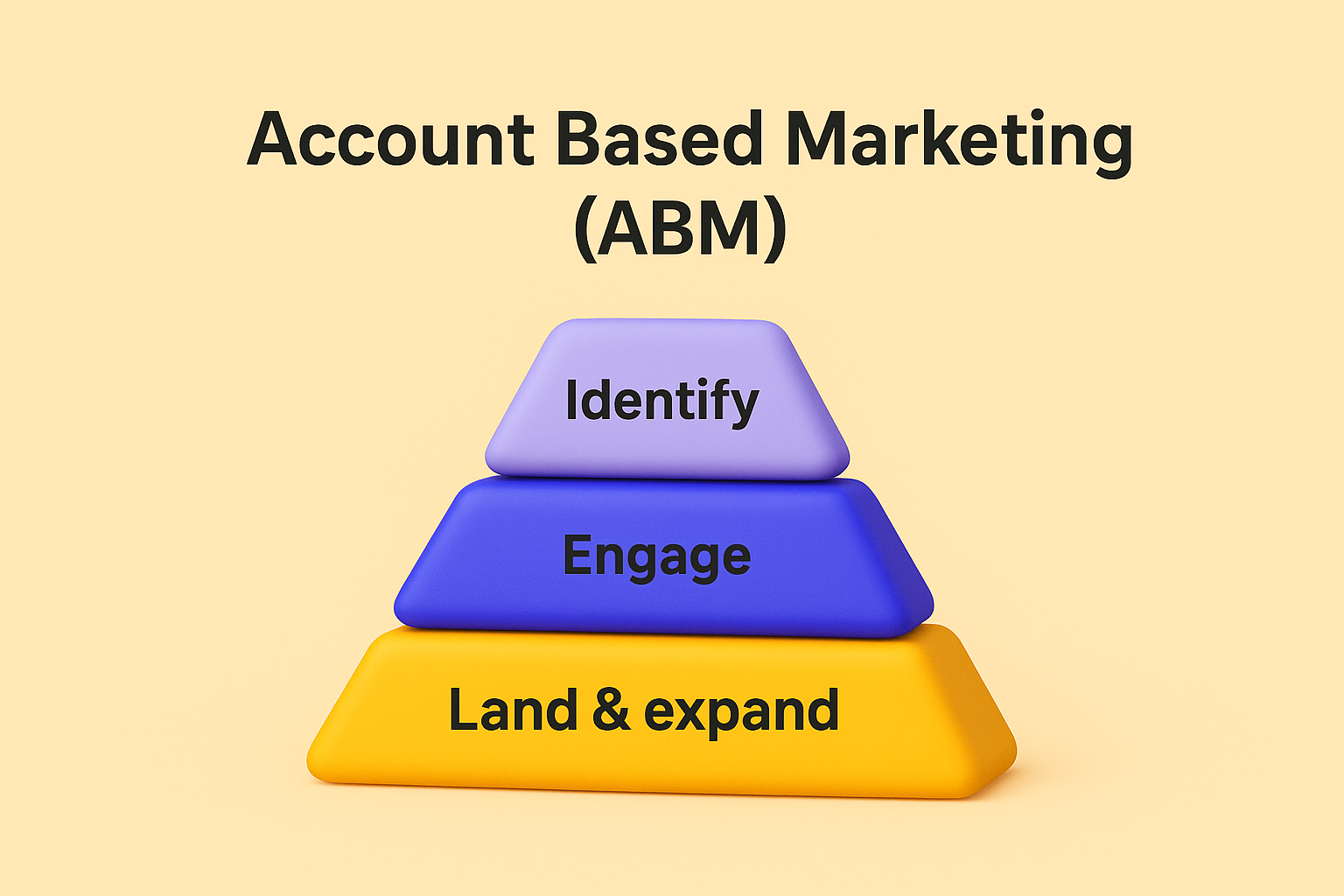When will AI-first go-to-market strategies become standard for B2B startups?
In the startup world, speed, precision, and adaptability determine survival. For years, B2B go-to-market (GTM) strategies were built around manual playbooks — human-driven market research, cold outreach, and campaign testing. But in 2025, a major shift is underway: AI-first GTM strategies are rapidly evolving from competitive differentiators into the new baseline for success.
The question isn’t if this will become standard — it’s how soon.
1. The Definition of an AI-First GTM Strategy
An AI-first GTM strategy integrates artificial intelligence at every stage of market entry — from audience discovery and content creation to lead scoring, pricing optimization, and post-sale engagement. Instead of using AI as a tool for efficiency, startups build their GTM model around it.
That means:
• AI defines the Ideal Customer Profile (ICP) using behavioral, intent, and firmographic data.
• Generative models craft personalized messaging and campaigns.
• Predictive analytics determine pricing, timing, and outreach cadence.
• Machine learning continuously refines performance based on real-time results.
This approach turns what was once an art of intuition into a science of precision.
2. The Acceleration Timeline: From Early Adoption to Standard Practice
2024–2025: The Experimentation Phase
We’re currently in the experimental stage. AI-native startups (especially in SaaS, fintech, and cybersecurity) are leading the charge by using AI copilots to identify target markets, generate content, and personalize outbound campaigns. Most GTM functions are still semi-automated, requiring human oversight.
2026–2027: Hybrid GTM Models Take Over
AI copilots will evolve into autonomous GTM agents capable of orchestrating entire campaigns. Founders and marketers will focus on strategy, brand, and partnerships — while AI handles segmentation, personalization, and pipeline prioritization. During this period, over 60% of B2B startups are projected to integrate AI-first systems into their GTM tech stacks.
2028 and Beyond: AI-First as the Default
By the end of the decade, AI-first GTM will become the standard playbook for launching, scaling, and optimizing B2B startups. Investors and accelerators will expect founders to show AI-driven market validation and predictive GTM modeling before funding rounds. Manual-only strategies will feel outdated — like ignoring SEO in 2010 or social media in 2015.
3. Why Startups Are Leading This Shift
• ⚙️ Resource Efficiency: Early-stage startups lack large teams. AI allows lean operations that compete with enterprise-level GTM performance.
• 🔍 Data-Driven Precision: AI identifies micro-segments and hidden market opportunities humans miss.
• 🚀 Speed to Market: Campaigns that once took weeks can now launch in hours with AI-powered automation.
• 💬 Personalization at Scale: LLMs enable startups to craft outreach messages and landing pages tailored to every buyer persona — without manual copywriting.
4. What’s Needed to Reach Full Maturity
Before AI-first GTM becomes truly ubiquitous, three challenges must be addressed:
• Data Unification: Many startups still lack clean, connected datasets across CRM, intent, and ad platforms.
• Ethical Guardrails: Transparency in AI-driven outreach and content remains critical to trust.
• Human Oversight: Creativity, empathy, and strategic intuition still matter — AI amplifies, but doesn’t replace them.
The Bottom Line
AI-first GTM strategies will likely become standard for B2B startups by 2028, with many early adopters achieving dominance well before then. These companies won’t just use AI to optimize — they’ll build their entire go-to-market motion around intelligence itself: dynamic ICPs, predictive lead scoring, adaptive pricing, and autonomous campaign management.
The next generation of successful startups won’t ask, “How can we add AI to our marketing?” — they’ll start with, “How can AI define our market?”
Read More: https://intentamplify.com/lead-generation/
In the startup world, speed, precision, and adaptability determine survival. For years, B2B go-to-market (GTM) strategies were built around manual playbooks — human-driven market research, cold outreach, and campaign testing. But in 2025, a major shift is underway: AI-first GTM strategies are rapidly evolving from competitive differentiators into the new baseline for success.
The question isn’t if this will become standard — it’s how soon.
1. The Definition of an AI-First GTM Strategy
An AI-first GTM strategy integrates artificial intelligence at every stage of market entry — from audience discovery and content creation to lead scoring, pricing optimization, and post-sale engagement. Instead of using AI as a tool for efficiency, startups build their GTM model around it.
That means:
• AI defines the Ideal Customer Profile (ICP) using behavioral, intent, and firmographic data.
• Generative models craft personalized messaging and campaigns.
• Predictive analytics determine pricing, timing, and outreach cadence.
• Machine learning continuously refines performance based on real-time results.
This approach turns what was once an art of intuition into a science of precision.
2. The Acceleration Timeline: From Early Adoption to Standard Practice
2024–2025: The Experimentation Phase
We’re currently in the experimental stage. AI-native startups (especially in SaaS, fintech, and cybersecurity) are leading the charge by using AI copilots to identify target markets, generate content, and personalize outbound campaigns. Most GTM functions are still semi-automated, requiring human oversight.
2026–2027: Hybrid GTM Models Take Over
AI copilots will evolve into autonomous GTM agents capable of orchestrating entire campaigns. Founders and marketers will focus on strategy, brand, and partnerships — while AI handles segmentation, personalization, and pipeline prioritization. During this period, over 60% of B2B startups are projected to integrate AI-first systems into their GTM tech stacks.
2028 and Beyond: AI-First as the Default
By the end of the decade, AI-first GTM will become the standard playbook for launching, scaling, and optimizing B2B startups. Investors and accelerators will expect founders to show AI-driven market validation and predictive GTM modeling before funding rounds. Manual-only strategies will feel outdated — like ignoring SEO in 2010 or social media in 2015.
3. Why Startups Are Leading This Shift
• ⚙️ Resource Efficiency: Early-stage startups lack large teams. AI allows lean operations that compete with enterprise-level GTM performance.
• 🔍 Data-Driven Precision: AI identifies micro-segments and hidden market opportunities humans miss.
• 🚀 Speed to Market: Campaigns that once took weeks can now launch in hours with AI-powered automation.
• 💬 Personalization at Scale: LLMs enable startups to craft outreach messages and landing pages tailored to every buyer persona — without manual copywriting.
4. What’s Needed to Reach Full Maturity
Before AI-first GTM becomes truly ubiquitous, three challenges must be addressed:
• Data Unification: Many startups still lack clean, connected datasets across CRM, intent, and ad platforms.
• Ethical Guardrails: Transparency in AI-driven outreach and content remains critical to trust.
• Human Oversight: Creativity, empathy, and strategic intuition still matter — AI amplifies, but doesn’t replace them.
The Bottom Line
AI-first GTM strategies will likely become standard for B2B startups by 2028, with many early adopters achieving dominance well before then. These companies won’t just use AI to optimize — they’ll build their entire go-to-market motion around intelligence itself: dynamic ICPs, predictive lead scoring, adaptive pricing, and autonomous campaign management.
The next generation of successful startups won’t ask, “How can we add AI to our marketing?” — they’ll start with, “How can AI define our market?”
Read More: https://intentamplify.com/lead-generation/
When will AI-first go-to-market strategies become standard for B2B startups?
In the startup world, speed, precision, and adaptability determine survival. For years, B2B go-to-market (GTM) strategies were built around manual playbooks — human-driven market research, cold outreach, and campaign testing. But in 2025, a major shift is underway: AI-first GTM strategies are rapidly evolving from competitive differentiators into the new baseline for success.
The question isn’t if this will become standard — it’s how soon.
1. The Definition of an AI-First GTM Strategy
An AI-first GTM strategy integrates artificial intelligence at every stage of market entry — from audience discovery and content creation to lead scoring, pricing optimization, and post-sale engagement. Instead of using AI as a tool for efficiency, startups build their GTM model around it.
That means:
• AI defines the Ideal Customer Profile (ICP) using behavioral, intent, and firmographic data.
• Generative models craft personalized messaging and campaigns.
• Predictive analytics determine pricing, timing, and outreach cadence.
• Machine learning continuously refines performance based on real-time results.
This approach turns what was once an art of intuition into a science of precision.
2. The Acceleration Timeline: From Early Adoption to Standard Practice
2024–2025: The Experimentation Phase
We’re currently in the experimental stage. AI-native startups (especially in SaaS, fintech, and cybersecurity) are leading the charge by using AI copilots to identify target markets, generate content, and personalize outbound campaigns. Most GTM functions are still semi-automated, requiring human oversight.
2026–2027: Hybrid GTM Models Take Over
AI copilots will evolve into autonomous GTM agents capable of orchestrating entire campaigns. Founders and marketers will focus on strategy, brand, and partnerships — while AI handles segmentation, personalization, and pipeline prioritization. During this period, over 60% of B2B startups are projected to integrate AI-first systems into their GTM tech stacks.
2028 and Beyond: AI-First as the Default
By the end of the decade, AI-first GTM will become the standard playbook for launching, scaling, and optimizing B2B startups. Investors and accelerators will expect founders to show AI-driven market validation and predictive GTM modeling before funding rounds. Manual-only strategies will feel outdated — like ignoring SEO in 2010 or social media in 2015.
3. Why Startups Are Leading This Shift
• ⚙️ Resource Efficiency: Early-stage startups lack large teams. AI allows lean operations that compete with enterprise-level GTM performance.
• 🔍 Data-Driven Precision: AI identifies micro-segments and hidden market opportunities humans miss.
• 🚀 Speed to Market: Campaigns that once took weeks can now launch in hours with AI-powered automation.
• 💬 Personalization at Scale: LLMs enable startups to craft outreach messages and landing pages tailored to every buyer persona — without manual copywriting.
4. What’s Needed to Reach Full Maturity
Before AI-first GTM becomes truly ubiquitous, three challenges must be addressed:
• Data Unification: Many startups still lack clean, connected datasets across CRM, intent, and ad platforms.
• Ethical Guardrails: Transparency in AI-driven outreach and content remains critical to trust.
• Human Oversight: Creativity, empathy, and strategic intuition still matter — AI amplifies, but doesn’t replace them.
The Bottom Line
AI-first GTM strategies will likely become standard for B2B startups by 2028, with many early adopters achieving dominance well before then. These companies won’t just use AI to optimize — they’ll build their entire go-to-market motion around intelligence itself: dynamic ICPs, predictive lead scoring, adaptive pricing, and autonomous campaign management.
The next generation of successful startups won’t ask, “How can we add AI to our marketing?” — they’ll start with, “How can AI define our market?”
Read More: https://intentamplify.com/lead-generation/
0 Комментарии
0 Поделились



